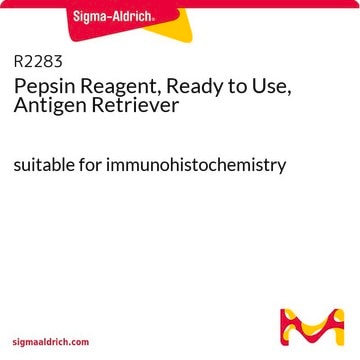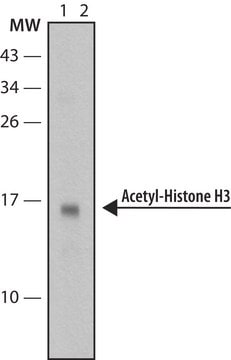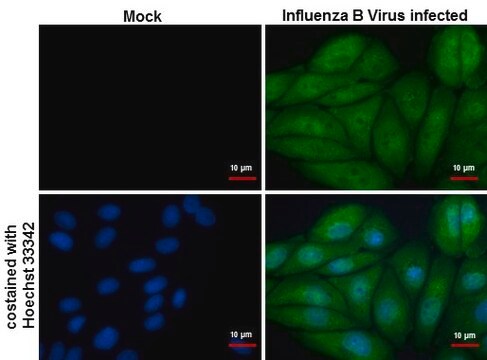MABD402
Anti-Neuroblasts Antibody, clone Nilo2
clone Nilo2, from hamster(Armenian)
Synonym(s):
Neuroblasts, Neuronal progenitors, Type A cells
About This Item
Recommended Products
biological source
hamster (Armenian)
Quality Level
antibody form
purified antibody
antibody product type
primary antibodies
clone
Nilo2, monoclonal
species reactivity
mouse
technique(s)
flow cytometry: suitable
immunohistochemistry: suitable
immunoprecipitation (IP): suitable
inhibition assay: suitable
magnetic resonance imaging (MRI): suitable
western blot: suitable
shipped in
ambient
target post-translational modification
unmodified
Related Categories
General description
Specificity
Immunogen
Application
Flow Cytometry Analysis: A representative lot, coupled to magnetic glyconanoparticles (mGNPs) or not, immunostained the surface of SVZ neurosphere-derived single cells (Elvira, G., et al. (2012). PLoS One. 7(9):e44466).
Flow Cytometry Analysis: Clone Nilo2 hybridoma culture supernatant stained the surface of 98% and 95% neurosphere-derived cells from mouse embryo olfactory bulb (OB) and adult mouse subventricular zone (SVZ), respectively (Del Valle, I., et al. (2010). Neuroscience. 169(3):1473-1485).
Immunocytochemistry Analysis: Representative lot immunostained early neural precursor cells by fluorescent immunocytochemistry staining of cultured neurospheres or neurosphere-derived single cells fixed with 4% paraformaldehyde. Unlike Nilo1 (Cat. No. MABD401), a small percentage of cells retained Nilo2 immunoreactivity even 7 days after differentiation induction by EGF and bFGF withdrawal in neurosphere cultures (Elvira, G., et al. (2012). PLoS One. 7(9):e44466; Del Valle, I., et al. (2010). Neuroscience. 169(3):1473-1485).
Immunofluorescence Analysis: Representative lots, when injected in mice, allowed the detection of labelled neuroblasts migrating towards brain injury sites due to CT-2A tumor growth or mechanical damage via stereotaxic PBS injection (Elvira, G., et al. (2015). Stem Cell Res. 14(1):114-129; Elvira, G., et al. (2012). PLoS One. 7(9):e44466).
Immunofluorescence Analysis: Representative lots immunostained post-mitotic neuronal precursors (e.g. type 1 neuroblasts), whereas Nilo1 (Cat. No. MABD401) stained quiescent neural progenitor cells in subventricular zone (SVZ) by fluorescent immunohistochemistry using 4% paraformaldehyde-fixed adult mouse floating sections (Elvira, G., et al. (2015). Stem Cell Res. 14(1):114-129; Elvira, G., et al. (2012). PLoS One. 7(9):e44466; Del Valle, I., et al. (2010). Neuroscience. 169(3):1473-1485).
Immunohistochemistry Analysis: A representative lot immunostained the thin layer of cells in the periventricular area inside the anterior SVZ (SVZa) at the beginning of the RMS, distinct from the small cell population lining the SVZ ventricle stained by Nilo1 (Cat. No. MABD401). Both Nilo1 and Nilo2 stained ependymal and subependymal layers in adult mouse olfactory bulb core, neither clone stained dentate gyrus (DG) of the hippocampus (Del Valle, I., et al. (2010). Neuroscience. 169(3):1473-1485).
Immunoprecipitation Analysis: A representative lot immunoprecipitated a ~150-170 kDa glycoprotein from neurosphere cell membrane extracts and from SVZ neurosphere cell lysates (Del Valle, I., et al. (2010). Neuroscience. 169(3):1473-1485).
Inhibition Analysis: A representative lot inhibited the differentiation of adult mice SVZ-derived neurospheres in culture as well as the proliferation of neurosphere-derived single cells (Del Valle, I., et al. (2010). Neuroscience. 169(3):1473-1485).
Western Blotting Analysis: A representative lot detected a ~150-170 kDa glycoprotein in the immunoprecipitates obtained by clone Nilo2 from neurosphere cell membrane extracts and from SVZ neurosphere cell lysates (Del Valle, I., et al. (2010). Neuroscience. 169(3):1473-1485).
Stem Cell Research
Quality
Immunohistochemistry Analysis: A 1:1,000 dilution of this antibody immunostained neuroblasts in subventricular zone (SVZ) of the lateral ventricle (LV) of 4% paraformaldehyde-fixed free-floating C57BL/6 mouse brain sections.
Target description
Physical form
Storage and Stability
Handling Recommendations: Upon receipt and prior to removing the cap, centrifuge the vial and gently mix the solution. Aliquot into microcentrifuge tubes and store at -20°C. Avoid repeated freeze/thaw cycles, which may damage IgG and affect product performance.
Other Notes
Disclaimer
Not finding the right product?
Try our Product Selector Tool.
Storage Class Code
12 - Non Combustible Liquids
WGK
WGK 2
Certificates of Analysis (COA)
Search for Certificates of Analysis (COA) by entering the products Lot/Batch Number. Lot and Batch Numbers can be found on a product’s label following the words ‘Lot’ or ‘Batch’.
Already Own This Product?
Find documentation for the products that you have recently purchased in the Document Library.
Our team of scientists has experience in all areas of research including Life Science, Material Science, Chemical Synthesis, Chromatography, Analytical and many others.
Contact Technical Service






